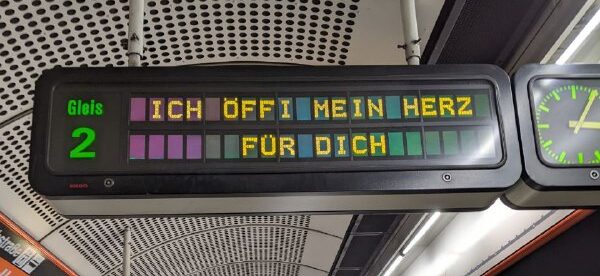Over the past few months, we have approached the subject of the subway from several perspectives, from its historical triumphal procession to the technical challenges of subway construction. And since things are unfortunately still looking bleak when it comes to travel, today we want to take you on a virtual ride on the Vienna subway – it has a lot more to offer than an excellently developed route network, modern trains and short intervals…
Whatever your field of study – the Vienna subway is just the thing for you!
Art?
The Vienna subway not only takes you to the many museums in the city. The stations themselves are worth a trip for art lovers. Would you like a small sample?
At the Westbahnhof, for example, there is the art wall “Approx. 55 steps through Europe” by Adolf Frohner, a visual association with the cultural history of Europe since the birth of Christ.

Those of you that prefer earlier artwork can drive a few stations further to the Volkstheater, where Anton Lehmden‘s mosaics depict the “origin of the universe from the big bang” and “the history of the development of nature on earth”. So when you’re waiting for the next train, leave your cell phone in your pocket and take a look at what’s going on a few meters above the tracks.

In Erdberg you will find art walls “Out of town” and “Inward into town” by Peter Atanasov, at Landstraße the “Passage West” with graffiti by Oswald Oberhuber and at Johnstraße the enamel picture “k. k. Spring parade on the Schmelz” after Felician von Myrbach.

Technical studies?
We definitely recommend a stop at Schweglerstraße, where you can not only admire all sorts of technical inventions on the way to the Technical Museum (e.g. a Mercury space capsule, a Mini Cooper or a sports aircraft are hanging from the ceiling in the elevators), but also the portraits and biographies of famous natural scientists and the “Tele-Archaeology” by the composer, sculptor and video artist Nam June Paik from 1994. This is a sculpture made of old bricks with electronic components embedded in them.
But the U2 station Stadion is also remarkable from a technical point of view, as there is an electronic counting and weighing system with real-time evaluations to measure the flow of people. Exciting, especially at major events such as the European Football Championship. And maybe also to calculate the average weight of a passenger?
From a technical point of view, the escalators of the Vienna underground are also worth mentioning. At an impressive 2.34 km/h they are among the fastest in Europe. For comparison: only the Prague subway has even faster escalators at 3.24 km/h, in Germany one travels at a comparatively comfortable 1.8 km/h.
History?
Apart from the very exciting history of the origins of the Vienna U-Bahn, which we have already reported on, it is in the nature of things that you always find exciting things when digging, especially in urban areas.
In Vienna, necessity has been made a virtue and so exciting relics can be found in several subway stations. For example, archaeological excavations are integrated into the Stubentor station, including around 20 meters of the Renaissance city wall and parts of the foundations of the Stubentor.
Also on Stephansplatz is the underground Virgil chapel, which was discovered in the 1970s during the construction of the subway. The insider tip is located practically directly under St. Stephen’s Cathedral and has been open to visitors again since 2015.

Of course, we in Vienna are always trying to write history with our subway – for example, the subway has been running 24/7 since 2010 (apart from a short Corona break).
But enough of the (semi-)historical facts, let’s move on to the next potential field of study, which is …
Architecture
What no one who has experienced the unique charm of many of Vienna’s underground stations will believe is possible: there was a special architectural competition in 1970. The winning team was commissioned to design the stations for the U1 and U4 lines. You don’t want to know what the not-so-good proposals looked like… The 70s are a chapter in their own right in terms of taste. The visual comparison with the design concept developed by Otto Wagner for the Wiener Stadtbahn is … painful. Extremely painful. But at least most of the Otto Wagner buildings were integrated unchanged into the subway design.

But what is indeed practical at the taste-confused stations: All walls are provided with uniform panels that can be quickly and easily exchanged if necessary. Clear case of “form follows function”.
What is really worth mentioning, however, is that unlike in other large cities, the passengers are not “guided”. There are no separate entrances and exits, nor is boarding and alighting via separate platforms. Cheers to the Viennese at this point – because it works. Usually …
Incidentally, in order to increase the subjective feeling of safety, optical accents are used – such as the bright design and lighting of the platforms – while the tracks appear very dark, “unprocessed” and uninviting. Sounds logical? However, it is apparently not a matter of course and is known as a design system under the name “Vienna System”. That’s where a bit of pride comes in.
What if your heart beats more for numbers than for architectural fun facts?
Mathematics/statistics!

In addition to the regular network, which covers an impressive 83 kilometers (and over 100 stops), there are several kilometers of “operating track”. The subway is fast and the network is extensive. Last year, the Viennese made more than a third of their trips by public transport (as much as on foot. Only 27 percent by car).
No wonder that in 2020, for the fourth year in a row, more people owned an annual pass than a car. 852,000 annual tickets were issued in 2019*. There are 143,000 fewer privately owned cars. In addition, the annual pass is extremely cheap at one euro per day.
Vienna’s means of transport are also well within the European average at €2.40 for any length of journey in one direction. A single trip on the Paris Metro, for example, costs €1.90, in Berlin you pay between €2.90 and €3.60, depending on the zone and route, and in Madrid between €1.50 and €3.00. Prague is below average at just under 90 cents. If you want to explore London, you can pay €5.00 for a single trip in the core zone.
What else?
We at eguana are dedicated public transport drivers – a short extrapolation shows that we make over 80 percent of the trips to our office on the subway. Lucky that we are equipped with job-/climate tickets. A trip with public transport is always worthwhile.
Apart from the fact that it can be extremely exciting to observe the passengers (and sometimes also a good training for more patience), the scoreboards in Vienna offer an entertaining variety and a sense of community – for example after the end of the first lockdown were greeted with “Welcome back”.
On the occasion of the discussion about the rainbow-colored captain’s armband of the German national goalkeeper Manuel Neuer, Wiener Linien published a picture in rainbow colors on social media with the inscription “We drive with the rainbow. It doesn’t hurt, dear Uefa”.
And for the 20th cinema birthday of “Harry Potter” on November 22nd trains were of course headed for Hogwarts!
Unfortunately, the trains do not (yet) go as far as Hogwarts in reality – but the rail network is currently being expanded – a project that we are proud to be part of!

